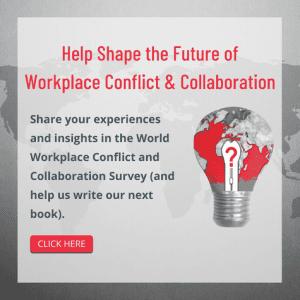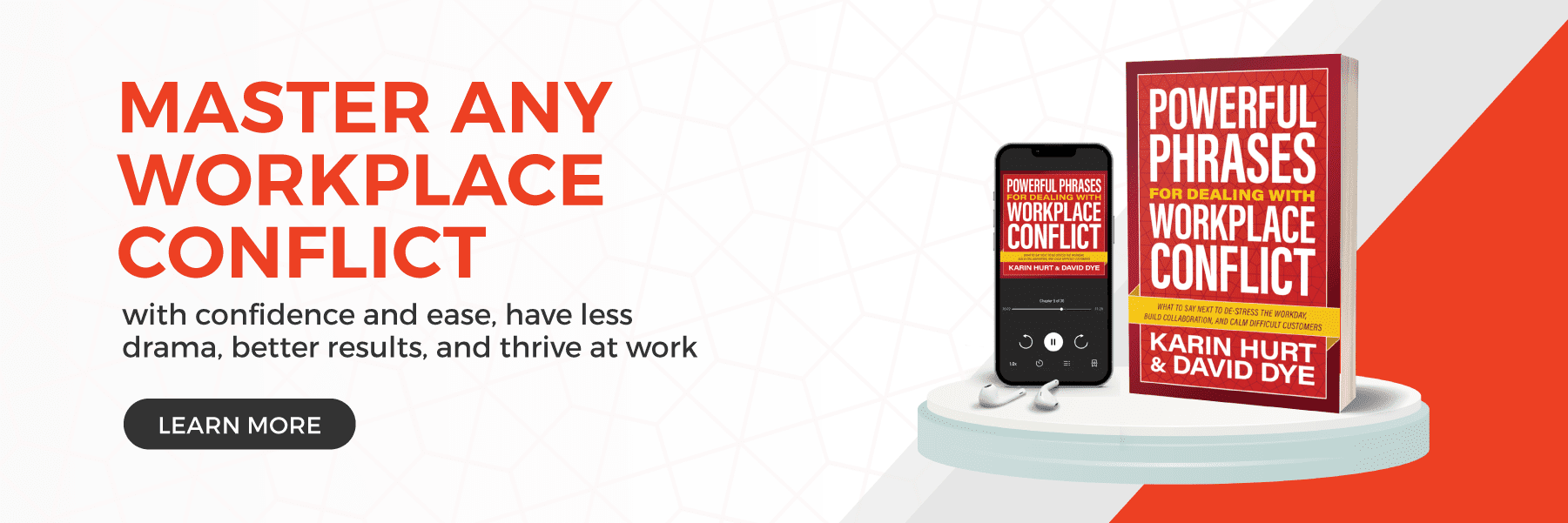Powerful Phrases to Confidently Confront a Bully at Work
Looking back I feel I should have stood for myself and not give into this bully. I only feared hurting her and not getting into an ugly argument. However, this has made me not decide so many things for myself like my career path, my job etc…at that time. I am much stronger now and would deal with such a bully differently if history was to repeat.
– Female, 47 Dubai (from our World Workplace Conflct and Collaboration Survey)
You would think by now, we’d be past the need to write about dealing with a workplace bully.
Most Gen Zs and Millennials have been told bullies are bad since elementary school. And if you’re a parent, you’ve probably pulled a peanut butter-stained, “How to Stop a Bully” flyer from your kid’s backpack and thought wistfully, “I wish they talked about bullying when I was in school. Surely, this focus will make for better grown-ups.”
Sigh.
We should all know better. But here we are. If you’ve Googled this and are here. We’re sorry. You shouldn’t have to deal with a bully at work.
What is Workplace Bullying?
What is workplace bullying? According to the National Bullying Hotline, here are five questions to ask yourself as a starting point.
- Do I feel intimidated or threatened at work?
- Am I regularly humiliated or ridiculed in front of my colleagues?
- Have I been called names?
- Are my efforts consistently undervalued or disregarded?
- Do I feel sick or nauseous when working with a particular colleague or manager?
If you have a cocktail of the above going on, chances are you’re dealing with some degree of workplace bullying, or at the very least toxic management or bad team culture. The approach below is meant to be a starting place for acute acts of workplace bullying. If you’re dealing with a chronic bully, PLEASE call HR and report the toxic courage crusher. You shouldn’t have to face this situation on your own.
How to Turnaround a Bullying Situation: Stories of Hope
In our research for our upcoming book on navigating workplace conflict, we’ve been talking to people who’ve confronted a workplace bully and changed the story. Many of these stories have two things in common. First, they found support from a trusted colleague so they weren’t managing the situation alone. And second, they didn’t react at the moment, but instead calmed down and planned a careful intervention to address the concern.
Here are two examples from our research. Let’s call them “Laura” and “George”
“Laura’s” Story (Now a CEO)
Laura shares her powerful example of asking for help and creating an intervention by asking a powerful question:
“Is this the way we’re going to work together?”
I was working on a project and somebody made a mistake (not related to me). But his boss thought I had made a mistake, and left me a scathing voicemail copying six other people on the team. He was really personal in the attacks. I was new in this position. And, even if I had been wrong, it was a horrible way to behave. Just so demeaning and so personal. So I went to a conference room and called one of my colleagues and decided to be vulnerable and ask for help to process what had happened. Being able to reach out to someone when I wouldn’t do that under normal circumstances meant the world.
And then…
I brought the team of people together, including the guy who had made the mistake. And in a moment of assertiveness I didn’t think I had in me I said, “Look, is this the way we’re going to work together? Where we’re blaming each other and yelling at each other, and there is public humiliation?” I was so frustrated and I found my voice that day.
The intervention worked. It was a declaration that I wasn’t the one to mess with. I think the best way to deal with a workplace bully is direct and strong and professional. You can’t let them get away with that behavior even if you’re in a junior position. I found with sloppy bullies like this that your own dignity and strength in the situation are embarrassing to them. And, it makes them look all the worse in front of anyone witnessing it. They’re less likely to mess with you in the future.
“George’s” Story (Now a Successful Entrepreneur)
George also gets some help, by inviting a neutral party in to verify the facts. And then uses this poignant powerful phrase:
“This is what it’s like to be me in this situation.”
My company was acquired into a very different culture and leadership style. There were so many tangly problems “collaborating” as we began working together.
One result of the collaboration failures is that I received critical materials for a presentation a few minutes before I needed to present—at the client site—to our C-suite sponsors.
So I’m updating our presentation deck (high-stress mode, because in moments I’m going to be the presenter, ready or not!) with part of the client team in the conference room. My new CEO is there. And as I’m racing to get this done, he’s growling negative feedback at me (targeted at me) about the presentation and shaking his head to emphasize his disappointment. He was making everyone uncomfortable, and setting exactly the wrong mood. And it was too late for it to be remotely constructive.
I waited a week to soften the emotional impact. Then I set up a call with my CEO and a project manager from his team (someone he trusted) that was in the room. I calmly painted a picture of what it was like to be me in that situation, and what I thought the client might have felt watching it go down.
I also successfully debunked some of the criticisms he’d given that I didn’t want to argue about with clients in the room.
Initially, he downplayed his behavior and denied that there were clients in the room while it was happening—but his project manager confirmed it all. My CEO took a long breath.
And then the CEO Said…
“It took great maturity and discipline for you to wait for the proper moment and environment to give me this feedback. Thank you.”
That conversation didn’t save the project, but it built more trust between the two of us. And I’m not taking all the credit. The CEO’s response to this conversation was obviously much more considered and strategic than his feedback at the client site.
From my perspective, the moral is that time, place, and company (who is there) all matter when you’re confronting a bully.
More Powerful Phrases for Dealing with a Workplace Bully
Talking with a workplace bully can feel like trying to reason with a grumpy cat – you may end up getting scratched, hissed at, or completely ignored. But with persistence and a strategic approach, you might just be able to tame the feline fiend and turn them into a more pleasant coworker.
1. Start with this powerful phrase. “That’s not okay.”
When a workplace bully starts to intimidate or belittle you, it’s vital to speak up with a hard stop. Saying “that’s not okay” sends a clear message that you won’t tolerate their bullying and that you expect them to treat you with respect.
Sure, it can be scary to confront a meanie. But you have the right to a safe and respectful workplace. By speaking up and setting boundaries, you are taking a powerful step towards protecting yourself and creating a more positive work environment for everyone.
Note: This is part of our series of Powerful Phrases for Dealing With Conflict at Work. Which we’re curating as we write our next book coming out next year. We would love to hear your insights (would you please take 5 minutes to contribute to our World Workplace Conflict and Collaboration Survey, click on the image on the right).
“Laura’s” question, “Is this the way we’re going to work together is a powerful variation of this powerful phrase posed as a question. And, “George” made an excellent case for why the behavior was not okay, with his phrase, “This is what it’s like to be me in this situation.”

2. “Nope. I can’t let you talk to me that way”
Workplace bullies often thrive on making others feel uncomfortable, so it’s important to assert your boundaries and let them know that their behavior is not acceptable.
By saying, “I feel uncomfortable with your behavior,” you’re making it clear that their actions are not welcome and that you will not tolerate being treated disrespectfully. This phrase is a simple and straightforward way to assert your boundaries and make it clear that you will not be intimidated.
3. “I would like to discuss this issue with you in a private setting.”
Many workplace bullies love to perform for a crowd. By saying, “I would like to discuss this issue with you in a private setting,” you’re taking control of the situation and removing the bully’s audience. This phrase is a respectful yet assertive way to communicate that you will not tolerate being bullied in front of others.
Both “Laura” and “George” made the wise move of letting some time pass, and then organizing a deeper conversation.
4. “I am not going to engage in this behavior.”
Workplace bullies often try to provoke others into a reaction. By saying, “I am not going to engage in this behavior,” you’re refusing to play into their game and asserting your right to be treated with respect. This phrase is a simple yet effective way to communicate that you will not be bullied into a reaction.
5. “I would like to involve HR in this discussion.”
By saying, “I would like to involve HR in this discussion,” you’re making it clear that the situation is serious. And, that you will not tolerate being bullied. This phrase is a powerful way to communicate that you are willing to take action to protect yourself and the good of the team.
Dealing with a workplace bully is never fun. And yet, quick action can prevent the situation from escalating. By using these powerful phrases, you can assert your boundaries and support a better workplace for others as well.
Your Turn
What advice do you have for someone dealing with a workplace bully?
Do you have a story about confronting a workplace bully or successfully navigating a workplace conflict? We would love to hear from you as part of our ongoing research. Please drop us a note at info@letsgrowleaders.com.








0 Comments